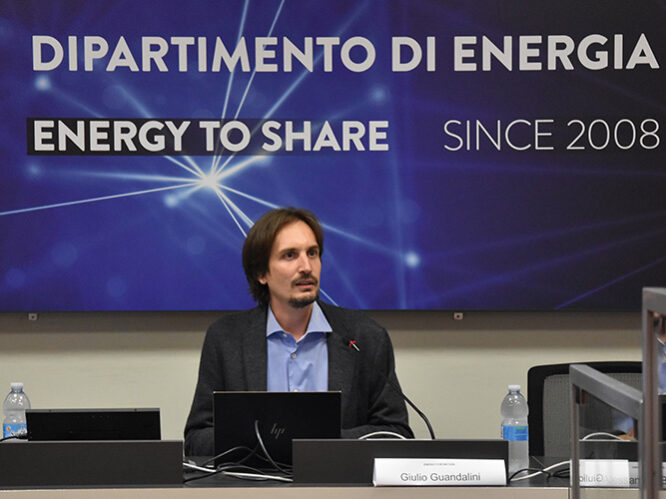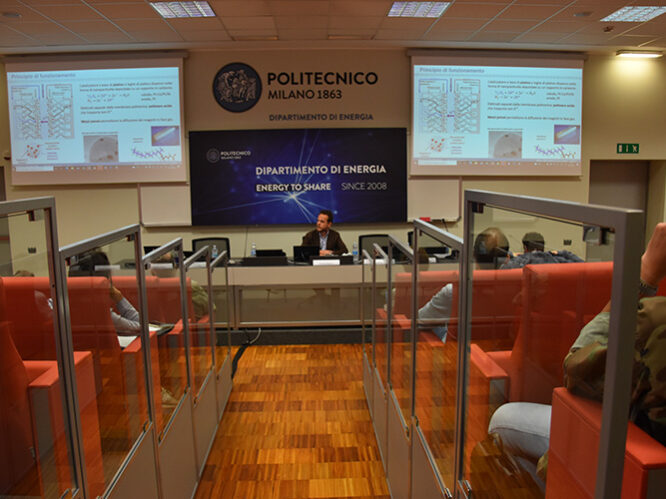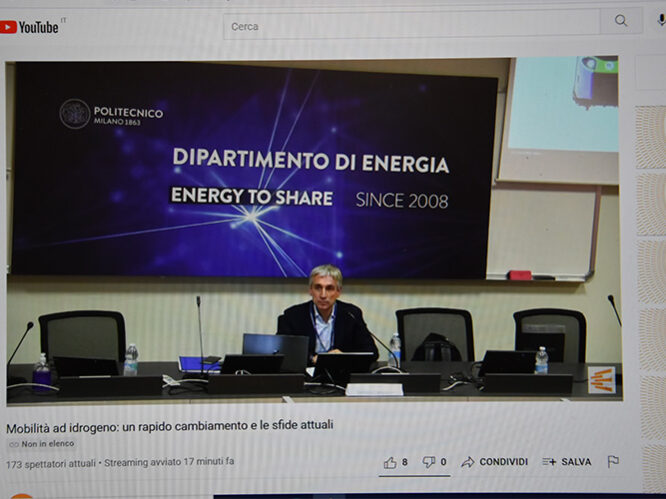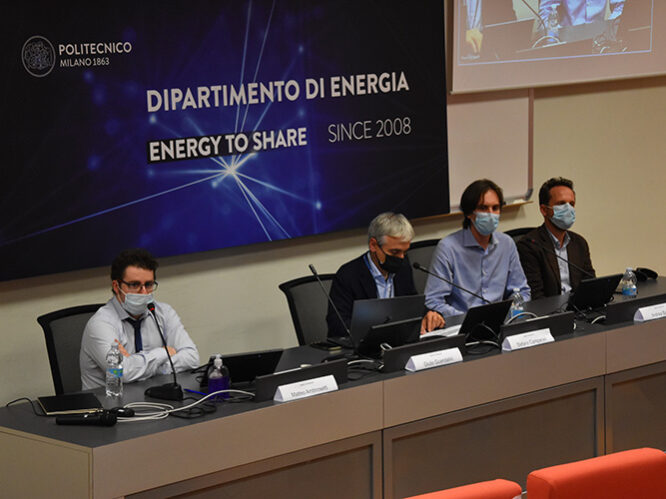Mobilità ad idrogeno: un rapido cambiamento e le sfide attuali
Photo of the event
Agenda
14:45 - 14:55
Opening – presentation of the project Energy for Motion
Content: She describes the contents of the seminar within the Energy for Motion project
14:55 - 15:10
The role of hydrogen for “sector coupling” in mobility and power applications
Content: He underlines the role of hydrogen towards a coupled and interconnected energy system
15:10 - 15:25
The challenge of durability in polymer-based fuel cells in the mobility sector
Content: He discusses about the causes of degradation in polymer-based fuel cells, how to foresee and mitigate it with appropriate experimental and theoretical approaches, with the aim to prolong the durability
15:25 - 15:40
Electrified Methane Steam Reforming in multifunctional and compact reactors: innovative solutions for production and distribution of hydrogen towards zero-emission
Content: He describes the different options available for promoting a spread usage of clean hydrogen by exploiting the design of novel catalytic material, key elements in steam reforming processes
16:00 - 16:20
Development of hydrogen-based railway systems
Content: Valter Alessandria presents the solutions in hydrogen powered trains provided by Alstom towards a CO2-clean Italian mobility
16:20 - 16:40
Applications in the railway sector: project “H2IseO”
Content: Stefano Erba from FNM talks about the decarbonization process of the local public transport by introducing hydrogen powered trains. This is the starting point for spreading the usage of hydrogen in an Italian integrated system
16:40 - 17:00
Question time: part 1
Speakers: Valter Alessandria – Alstom, Stefano Erba – FNM
17:00 - 17:20
Development of hydrogen power train for heavy duty applications
Content: Michele Miccio underlines issues and future perspectives when trying to implement hydrogen technology in heavy duty applications.
17:20 - 18:00
Design of polymeric materials for applications in hydrogen economy
Content: He talks about the methods to chemically design polymeric materials to be used as part of fuel cells or electrolizers.
18:00 - 18:20
Question time: part 2
Speakers: Giulio Guandalini and Andrea Baricci and Matteo Ambrosetti – Politecnico di Milano, Stefano Erba – FNM, Michele Miccio and Marco Rocchini – FTP Industrial, Claudio Oldani – Solvay
Opening – presentation of the project Energy for Motion
(video of the single speech)
Summary: The project Energy for Motion – Department of Excellence, funded by the Italian Ministry of Research within 2018-2022, has the goal of promoting the development of a sustainable mobility through novel technologies and fuels for new-generation hybrid vehicles, fuel cells and batteries.
Particular attention has been devoted to maintain and develop already existing or novel laboratories and activate new research pathways. High-level education has been promoted through doctoral courses, research positions and scientific dissemination. All the activities of the project are developed by collaborating with experts coming both from the industrial and the academic energy field.
The seminar will cover the current production, distribution, and usage of hydrogen in the mobility sector and the state of research in academic laboratories or at the industrial level.
The role of hydrogen for “sector coupling” in mobility and power applications
(video of the single speech)
Summary: Hydrogen is considered, in a way which is complementary to electricity, among the clean energy vectors able to sustain the achievement of decarbonization targets, thanks to its versatility and to the possibility to interweave in a number of energy sectors, linking with other energy vectors such as bio-fuels.
The resulting interconnected and “coupled” energy system will lead to several benefits helping in saving costs, energy and emissions. To fulfill this goal, technologies, and infrastructures already available should be employed in synergy for different applications, spanning from power generation, industry, and civil needs, such as for a sustainable mobility, decarbonization of industrial processes and energy storage.
To achieve a zero-emission scenario by using affordable/cheap green hydrogen from electrolysis, a relevant role in the energy transition is expected for “blue hydrogen” obtained from carbon capture, reaching in a long-term projection the elimination of grey hydrogen from steam reforming.
The challenge of durability in polymer-based fuel cells in the mobility sector
(video of the single speech)
Summary: Electrodes and polymeric electrolytes are the most stressed components within fuel cells. The overall efficiency of the cell is subjected to a consistent degradation which can be afforded by combining experimental (research on novel materials) and theoretical approaches.
The main objective of the European project ID-FAST is the development of dynamic simulations of the whole fuel cell system and environment of operation, basing on driving cycles which define the operative conditions of work more critical for material durability, such as temperature, relative humidity, cathodic potential. Once these parameters have been identified, appropriate mitigation strategies can be implemented.
Moreover, novel experimental tests have been formulated for simulating real cell performances, both for high and low power conditions of work. With these methods, degradation occurring in real fuel cell systems can be foreseen, allowing the precise evaluation of the service life of a fuell cell in a more general application simply modeled by merging high and low power cycles.
Electrified Methane Steam Reforming in multifunctional and compact reactors: innovative solutions for production and distribution of hydrogen towards zero-emission
(video of the single speech)
Summary: The evolution towards a distributed usage of clean and “decarbonized” hydrogen faces some fundamental issues to be solved, as the capture of CO2 produced in methane steam reforming at the large scale, along with the conversion and transportation of hydrogen carriers in the existing gas distribution lines.
The evolution from the macro to the small scale production and distribution of hydrogen to the final user is critical. These fundamental points are addressed in the European project ERC INSTANT, in which the production of hydrogen at the small scale is made possible by reactors equipped with nanostructured and conductive catalysts with novel designs. They can maximize the productivity per unit volume in steam reforming processes, by relying on the enhanced heat transfer properties, independently from flux velocity and hence, on the scalability of the system.
Moreover, the nanostructured catalyst is conductive and can be electrified and provide heat by Joule effect, operating as heating source to activate chemical reactions in reforming processes. This paves the way towards a considerable cut in CO2 emissions originated from methane combustion, used previously as conventional source of heat. Now, the remaining CO2 volumes emitted from chemical reactions can be easily handle and be fully decarbonized.
Development of hydrogen-based railway systems
(video of the single speech)
Summary: Hydrogen powered trains are pioneer in zero-emission mobility and represent a true alternative to diesel powered trains in commercial transportation. The combination of fuel cells powered by hydrogen and high-performing batteries allows to store the extra energy not immediately required, to cut the energy consumption during accelerations while ensuring high level of performances comparable to conventional diesel trains.
This technology is characterized by excellent autonomy as a diesel-powered train (600-700 km with one refill), outperforming trains equipped with batteries only, which are suited for short travels within 60-70 km in distance.
In Italy hydrogen trains are a promising solution because 30% of the lines are not electrified, for more that 7200 km. Several companies operating in railway mobility are financially supporting the transition to a low-carbon Italian transport system.
Applications in the railway sector: project “H2IseO”
(video of the single speech)
Summary: FNM and Trenord collaborate with the aim to create a fully-decarbonized mobility system at all levels, where novel railway technologies are a part of a complex system of production and storage of hydrogen for a variety of usage.
The project “H2IseO Hydrogen Valley” for the railway Brescia-Iseo-Edolo has the target to fully decarbonize the local public transport in Val Camonica within 2025, by following progressive steps. The line will be renewed with hydrogen powered trains by Alstom, while new plants for clean hydrogen production will be developed. The project aims at completely replacing diesel power trains on Brescia-Iseo-Edolo, with an important focus on creating a diffused network of hydrogen production and storage to be employed in diversified applications.
Question time: part 1
(video of the single speech)
Summary: The first question to Alstom regards the pressure of storage of hydrogen and the refill time with respect to a diesel train. The answer is respectively 350 bar with refill time in the range 20-25 minutes, in line with a diesel train. The final target is to employ green hydrogen, or with carbon sequestration processes, towards zero-emissions. Frequencies and costs of maintenance cannot be easily foreseen due to a lack of available data for such a novel technology. An important role is played by the durability of the fuel cells, expected to rise further in the next years due to the fast progress of the existing technology.
The legal approval of the technology is complex and time-consuming, being the related risks currently under investigation. They are connected to the specific geographical region of operation, for example possible losses of hydrogen from tanks when travelling in galleries.
Development of hydrogen power train for heavy duty applications
(video of the single speech)
Summary: For commercial applications in zero-emission heavy duty, hydrogen-based fuel cell is an advantageous choice because it provides a fast refill comparable to a diesel-powered vehicle (10-15 minutes), high calorific value of hydrogen and a reduced total cost of ownership.
The main goal for hydrogen powered heavy duty is to adjust costs and performances to the corresponding diesel system. In detail, costs related to weight and volume of hydrogen stored on bord should be further minimized. Moreover, critical issues related to heat dissipation, limited durability of components and efficiency should be solved. The maximization of efficiency is fundamental because it leads to a general reduction of the amount of hydrogen required, hence cutting the total cost of ownership of the vehicle.
FTP-Industrial promotes the diffusion of hydrogen in heavy duty mobility by financing several projects, such as H2Haul and Immortal.
Design of polymeric materials for applications in hydrogen economy
(video of the single speech)
Summary: Nowadays the market of polymeric materials for fuel cells and electrolysis is offering a novel type of ionic perflourinated polymer. Material properties of ionomers have to be optimized in view of maximizing mechanical and chemical stability, along with enhanced electrochemical performance with abated costs.
For instance, the reduction in length of the lateral chains in such ionomers enhances both mechanical and thermal resistance, to be added to an improvement of electrochemical performances.
Moreover, depolarization of polymers, expected typically in harsh environment as in fuel cells, can be avoided by introducing special chemicals or stabilization processes. These methods improve the structural stability of the material against degradation in time, increasing durability and efficiency.
Question time: part 2
(video of the single speech)
Summary: The first question from the audience underlines the importance of “sector coupling” for producing both electricity and hydrogen. Indeed, to overcome the seasonal oscillation of energy production from photovoltaics, photovoltaic plants should be supported by electrolysis systems, which would operate in hours not covered by photovoltaic energy. Then it is stressed the importance of the final application of the vehicle, regarded as an essential aspect able to guide market and research towards novel technological solutions, keeping the target of cutting the gap between diesel-based and hydrogen-based systems. In case of heavy duty, research is driven towards overcoming challenges related to the storage of hydrogen on board, or the usage of hydrogen as a fuel for internal combustion engines. The mass of vehicles or the spreading of distribution infrastructures for hydrogen transportation are fundamental elements to be considered in view of developing technologies based on hydrogen or batteries, while balancing costs and industrial feasibility.














